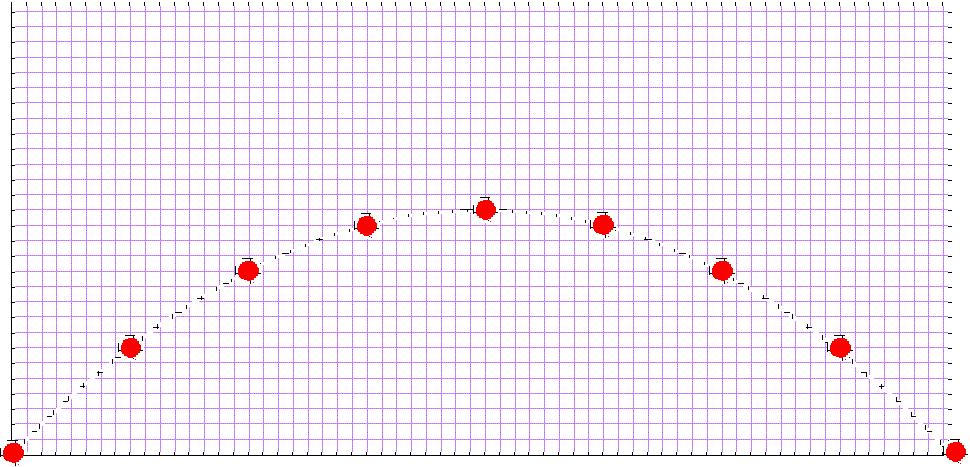
Due October 22, 1996, 2:00pm.
Read Chapter 4 of Cromer's book.

1. The above picture represents the flight of a ball thrown into
the air (although air resistance effects have been neglected).
The background grid is in one-foot squares. The blobs represent the
position of the ball at successive quarter-second intervals.
(a) By counting lines, find the average horizontal velocity of
the ball, in feet per second, during the first quarter of a second.
(Remember, each square is one foot across (from side to side or top to
bottom), and average speed = distance/time.)
(b) By reviewing the whole picture, find how the horizontal velocity
(in feet per second) varies throughout the flight.
(c) By counting squares, find the average vertical velocity of
the ball during the first quarter of a second.
(d) Make a table of the ball's average vertical velocity for all
eight quarter-second periods in the flight. Count velocity upwards
as positive, downwards as negative.
(e) Use your results from part (d) to plot a graph of the ball's
vertical velocity (on the y-axis) as a function of
time (on the x-axis) for the whole flight.
(f) Acceleration is rate of change of velocity. It is measured
here in feet per second per second. Use your graph from (e) to plot
a graph of the vertical acceleration as a function of time for
the whole flight.
(g)What can you conclude about the acceleration of the ball at the
topmost point of the path?
(h)Suppose now instead that the ball had been thrown directly upwards. Would it be accelerating at the topmost point of its flight?
(i) Galileo states in Two New Sciences (page 153): "..so far as I know, no one has yet pointed out that the distances traversed, during equal intervals of time, by a body falling from rest, stand to one another in the same ratio as the odd numbers beginning with unity". (The odd numbers beginning with unity just means 1, 3, 5, 7, ...). Show how you can verify this assertion using the picture above. What are the total distances fallen at the end of each quarter second starting from rest (at the top)?

Questions on the reading assignment. (Note: chapter 4 of Cromer is a very short discussion of a very complex subject, so only a few points are made. It is necessarily a simplified presentation---it's hard to cover most of civilization in a book this length! You might find it a bit offensive in some places---Cromer, who is Jewish, is evidently not a great admirer of his own peoples' religion (or anybody else's, it appears). I do think, though, that he makes some valid points here that are worth thinking about carefully.)
I expect about four or five lines on each part here, on average -- one or two might be quite short.
(2)(a) In a few sentences, how did the ancient Greek view of the
supernatural world differ from that of the Jews?
(b) How did the Greek view of authority differ from that of the
Jews?
(c)How did the Greek view of knowledge differ from that of the
Jews?
(d)Would you say geography played any role in the differing developments
of these two peoples? If so, how?
(e)For what, if anything, were the Jews indebted to the earlier
Egyptian civilization?
(f)For what, if anything, were the Greeks indebted to the earlier Egyptian civilization? (You should check Chapter 5 for this point---it was assigned reading on homework #2)